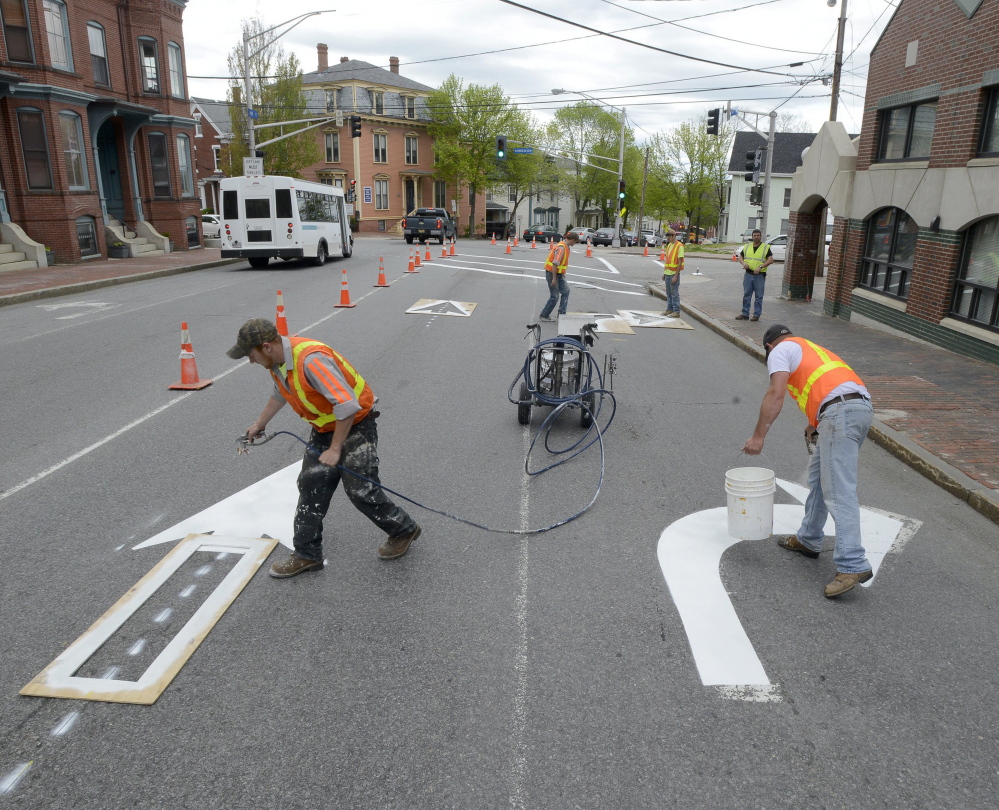Portland officials will lay out plans Monday night for a study to evaluate the effects of reintroducing two-way traffic on State and High streets.
A public workshop to explain the study’s goals and methodology is scheduled for 6 p.m. in the State of Maine Room at City Hall.
A city working group called the State and High Streets Project Advisory Committee in July began exploring the potential benefits and drawbacks of converting State and High streets to two-way traffic in response to concerns about pedestrian safety on the two busy arterials that cut through downtown.
The study will examine factors such as mobility, parking and safety, as well as estimating the approximate costs to make any proposed changes, including already needed upgrades.
Monday’s workshop will include a 30-minute presentation on the study, followed by break-out sessions focused on different aspects of the potential traffic pattern changes, working group spokeswoman Carol Morris said.
Attendees will have the opportunity to provide feedback about which issues the city should focus on when making its decision, such as pedestrian access, traffic speeds and the availability of parking, she said.
“This is a study that is going to look at these things and get some data,” Morris said. “There is no preconceived idea of whether this is a good idea or not.”
The workshop is expected to last about 90 minutes, she said.
The two parallel streets have been restricted to one-way traffic since the 1970s and are popular thoroughfares for drivers passing between Interstate 295 and the Casco Bay Bridge, although the city has tried to divert some of that traffic to the Fore River Parkway.
Some neighborhood residents and cyclists complain that many drivers on State and High streets exceed the 25 mph speed limit, making it dangerous to cross or ride a bike on the streets.
At least seven intersections along State and High streets on the peninsula were rated as “high crash locations” between 2011 and 2013 when compared to statewide averages, according to data supplied to the committee. They included where Park Avenue intersects both streets, as well as the larger intersection of State, Forest Avenue and Marginal Way.
Also, eight block segments were rated as “high crash locations,” although traffic engineers have said many of those were related to parking or sideswipes.
Over the next eight months, consultants will work with the city and the advisory committee to study the issue before making a formal recommendation to the City Council. The committee, which contains representatives of business and civic groups, as well as government agencies, plans to evaluate how the change would impact drive times and traffic volume through Portland.
Committee members have cited potential benefits of switching to two-way traffic that include lower average vehicle speeds, increased visibility for businesses along the corridors, improved connectivity among parts of Deering Oaks bisected by the road, and allowing drivers to take more direct routes to some destinations.
Also, members have said two-way traffic could reduce the risks of car-pedestrian incidents in crosswalks. Under the current configuration, pedestrians can be obscured by the first stopped car as they approach the second lane.
However, several committee members also have pointed out potential drawbacks to the change. Representatives of local churches and the Westin Portland Harborview Hotel have said that reverting to two-way traffic likely would result in the loss of some on-street parking. In some cases, parking spaces near intersections may have to be removed to provide additional space for turning traffic.
Other potential drawbacks identified by committee members were increased congestion along the two corridors, more traffic on nearby streets as drivers seek to avoid traffic, snow removal challenges and the possibility of head-on collisions.
Portland’s re-evaluation of State and High streets is part of a national trend as city planners convert the traffic flow on major one-way streets to two-way traffic in an effort to make downtown areas more pedestrian- and cyclist-friendly.
Portland officials also are evaluating potential changes to Congress Square, Spring Street, Franklin Street and the Commercial and High streets intersection that could affect any decision about changing the traffic flow on State and High streets.
Staff Writer Kevin Miller contributed to this report.
Send questions/comments to the editors.




Comments are no longer available on this story